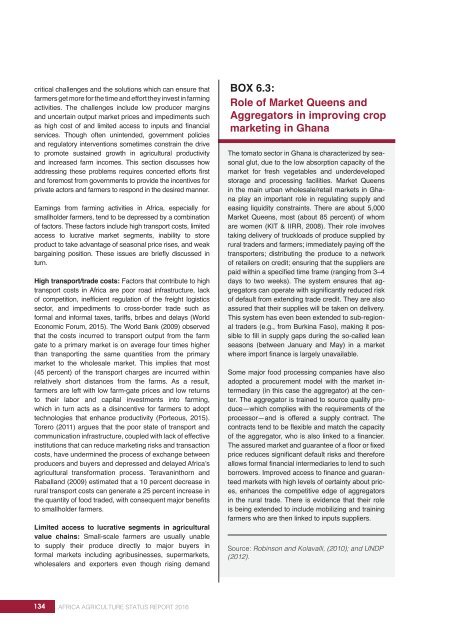AFRICA AGRICULTURE STATUS REPORT 2016
AASR-report_2016-1
AASR-report_2016-1
You also want an ePaper? Increase the reach of your titles
YUMPU automatically turns print PDFs into web optimized ePapers that Google loves.
critical challenges and the solutions which can ensure that<br />
farmers get more for the time and effort they invest in farming<br />
activities. The challenges include low producer margins<br />
and uncertain output market prices and impediments such<br />
as high cost of and limited access to inputs and financial<br />
services. Though often unintended, government policies<br />
and regulatory interventions sometimes constrain the drive<br />
to promote sustained growth in agricultural productivity<br />
and increased farm incomes. This section discusses how<br />
addressing these problems requires concerted efforts first<br />
and foremost from governments to provide the incentives for<br />
private actors and farmers to respond in the desired manner.<br />
Earnings from farming activities in Africa, especially for<br />
smallholder farmers, tend to be depressed by a combination<br />
of factors. These factors include high transport costs, limited<br />
access to lucrative market segments, inability to store<br />
product to take advantage of seasonal price rises, and weak<br />
bargaining position. These issues are briefly discussed in<br />
turn.<br />
High transport/trade costs: Factors that contribute to high<br />
transport costs in Africa are poor road infrastructure, lack<br />
of competition, inefficient regulation of the freight logistics<br />
sector, and impediments to cross-border trade such as<br />
formal and informal taxes, tariffs, bribes and delays (World<br />
Economic Forum, 2015). The World Bank (2009) observed<br />
that the costs incurred to transport output from the farm<br />
gate to a primary market is on average four times higher<br />
than transporting the same quantities from the primary<br />
market to the wholesale market. This implies that most<br />
(45 percent) of the transport charges are incurred within<br />
relatively short distances from the farms. As a result,<br />
farmers are left with low farm-gate prices and low returns<br />
to their labor and capital investments into farming,<br />
which in turn acts as a disincentive for farmers to adopt<br />
technologies that enhance productivity (Porteous, 2015).<br />
Torero (2011) argues that the poor state of transport and<br />
communication infrastructure, coupled with lack of effective<br />
institutions that can reduce marketing risks and transaction<br />
costs, have undermined the process of exchange between<br />
producers and buyers and depressed and delayed Africa’s<br />
agricultural transformation process. Teravaninthorn and<br />
Raballand (2009) estimated that a 10 percent decrease in<br />
rural transport costs can generate a 25 percent increase in<br />
the quantity of food traded, with consequent major benefits<br />
to smallholder farmers.<br />
Limited access to lucrative segments in agricultural<br />
value chains: Small-scale farmers are usually unable<br />
to supply their produce directly to major buyers in<br />
formal markets including agribusinesses, supermarkets,<br />
wholesalers and exporters even though rising demand<br />
BOX 6.3:<br />
Role of Market Queens and<br />
Aggregators in improving crop<br />
marketing in Ghana<br />
The tomato sector in Ghana is characterized by seasonal<br />
glut, due to the low absorption capacity of the<br />
market for fresh vegetables and underdeveloped<br />
storage and processing facilities. Market Queens<br />
in the main urban wholesale/retail markets in Ghana<br />
play an important role in regulating supply and<br />
easing liquidity constraints. There are about 5,000<br />
Market Queens, most (about 85 percent) of whom<br />
are women (KIT & IIRR, 2008). Their role involves<br />
taking delivery of truckloads of produce supplied by<br />
rural traders and farmers; immediately paying off the<br />
transporters; distributing the produce to a network<br />
of retailers on credit; ensuring that the suppliers are<br />
paid within a specified time frame (ranging from 3–4<br />
days to two weeks). The system ensures that aggregators<br />
can operate with significantly reduced risk<br />
of default from extending trade credit. They are also<br />
assured that their supplies will be taken on delivery.<br />
This system has even been extended to sub-regional<br />
traders (e.g., from Burkina Faso), making it possible<br />
to fill in supply gaps during the so-called lean<br />
seasons (between January and May) in a market<br />
where import finance is largely unavailable.<br />
Some major food processing companies have also<br />
adopted a procurement model with the market intermediary<br />
(in this case the aggregator) at the center.<br />
The aggregator is trained to source quality produce—which<br />
complies with the requirements of the<br />
processor—and is offered a supply contract. The<br />
contracts tend to be flexible and match the capacity<br />
of the aggregator, who is also linked to a financier.<br />
The assured market and guarantee of a floor or fixed<br />
price reduces significant default risks and therefore<br />
allows formal financial intermediaries to lend to such<br />
borrowers. Improved access to finance and guaranteed<br />
markets with high levels of certainty about prices,<br />
enhances the competitive edge of aggregators<br />
in the rural trade. There is evidence that their role<br />
is being extended to include mobilizing and training<br />
farmers who are then linked to inputs suppliers.<br />
Source: Robinson and Kolavalli, (2010); and UNDP<br />
(2012).<br />
134 <strong>AFRICA</strong> <strong>AGRICULTURE</strong> <strong>STATUS</strong> <strong>REPORT</strong> <strong>2016</strong>


